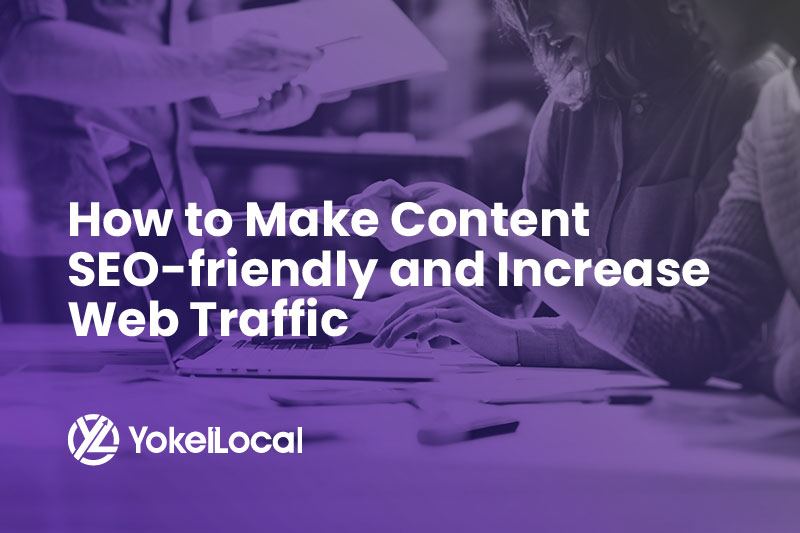Location means everything for your business, and one of the most prime locations is where your website ranks on Google. Higher positioning in Google search results (for the right keyword phrases) means more visibility for your business or brand. More visibility means you can drive more traffic to your website. But your competitors know this as well. If you’re having trouble outranking them on Google, you might need to change your search engine optimization (SEO) practices.
How to Improve Google Search Rankings for Your Company’s Website & Outrank Your Competition
Most customers make purchase decisions based on what they see about a company online, which makes it imperative that you increase your website visibility. If you’re not on page one for a key search result, more likely than not, your target customer won’t find you. Think about it: when was the last time you looked on page two or three of Google?
So when your competition outranks you in Google, you are less likely to get your target audience to visit your website. The good news is there are a ways to push your rankings up and outrank your competitors. However, while you can implement great SEO tactics, the results often take time. Here’s why:
16 Truths on Outranking Competitors on Google With SEO
You can build a strong web presence by understanding the core SEO fundamentals and building strategies and tactics that take these fundamentals into account. Let’s take a look at these core fundamentals that are affecting your website ranking and discuss what you can do about them.
1. Brand-New Websites Don't Work Well Because They Don't Have "Authority"
Authority basically refers to how much others value a website as a source for information. Google gives websites that are seen as subject matter authorities higher rankings than those that aren’t. One powerful way to gain authority is through backlinks (other websites that link to you). However, new websites haven’t been around for very long, so they typically don’t have many (if any) backlinks.
2. Backlinks Are the Biggest Factor For Building Authority
Google treats backlinks, or hyperlinks from other websites that redirect to yours, as a proxy for your website’s authority. Think of a backlink like a “vote” of approval. For example, if publishers of another website find your content useful and authoritative, they may use your ideas and publish a blog post on their website. They then link to your website to give you credit and to cite you as the resource. With more backlinks, you can improve your website’s authority while also increasing quality traffic. However, as we’ll discuss in #3, not all backlinks are created equal. You want quality over quantity.
3. Get Backlinks From a Variety of Domains with Good Authority
Backlinks are crucial if you want to build your website’s authority, but quantity alone won’t help you rank. Let me stress this: you want quality over quantity. Google looks at the quality of those website domains that link to you. Just like how your website has a certain amount of domain authority, other websites have a certain amount as well. Getting one link from a higher authority website is better than a hundred links from a very low authority website. Getting many low quality backlinks is spammy and may end up hurting you in the long run.
There are a variety of tools you can use to measure the domain authority score of a website. Many of these tools give a score from 0-100, with 100 being the highest. You should aim to get backlinks from higher authority websites.
In addition to quality of the linking domains, Google also places a high value on backlinks when they come from many different domains instead of just a one or two. Google is much more likely to treat your website as trustworthy when it sees a wide variety of domains connecting to you and giving your site a vote of approval.
4. If You're Not Doing Outreach, Backlinks Will Not Magically Appear
Everyone today knows that content is king, but that doesn’t mean your high quality content will automatically start collecting backlinks. You’ll have to network with websites, bloggers, social media personalities, and other influencers that are relevant to your industry to get backlinks. Guest blogging is one popular form of backlinking that allows you use someone else’s reputation to raise your own.
5. Building Site Authority Takes Time
Authority is a reflection of your reputation, which will take time for you to build through blogging, connecting with other websites, and attracting visitors to your website. Depending on the competitiveness of your industry, you may have to wait anywhere from six months to a year to see a major improvement in your ranks (assuming you are actively doing proper SEO practices).
6. Your Web Page's "RELEVANCE" to Search Queries Are a Huge Factor to Ranking
Google places a high priority on showing its users content that is directly relevant to their keyword searches. So, in order for Google to even consider placing one of your website’s pages in the search results for a searched query, that page needs to actually contain content that is relevant to that query.
7. User Experience Signals on Your Website Matter to Google
Google utilizes metrics known as user experience signals to help determine web rankings. The most important of these are the click-through rate (CTR), which refers to how many users click on your site from a SERP, and the bounce rate, or the ratio of users who return to a SERP from your page (i.e. push the back button without viewing another page on your site). Google also tracks dwell time, or how long users remain on a page, as well as your return visitors. What it comes down to is the fact that high engagement with your site is a signal to Google that your website content is high quality and useful.
8. Headlines Are the Key to Good Click-Through Rates (and Higher Rankings)
When people search Google, what are they greeted with in the search results? A list of different web pages that meet your search criteria. Google lists each individual result with the following: a headline or title tag of the webpage, the URL, and a short description of that page (the meta description). These title tags and meta descriptions are the hooks that draws users to your page. Strong headlines or titles can boost your CTR if they are relevant to your target audience. Compare the snippets for websites that rank on the first page to yours to spot any changes you may need to make.
9. Google's Algorithm Prefers New and Fresh Content
Content marketing is a huge part of good SEO strategies. Users today want new, relevant, and engaging content, and so does Google. Update your old blog posts with new information if they’re ranking poorly, and flesh-out or replace thin content with well-researched, information-dense pieces.
10. Your Site Might Just Be Too Slow
Google began to strongly prioritize load times for rankings with its 2018 Mobile First update. Long load times drive up bounce rates as users abandon slow sites for faster ones. Try to keep load times for your desktop and mobile sites below 5 seconds, and under 3 seconds if possible.
11. Your Website Must Be Mobile Friendly
Not only do you need a quick load time for your website in the age of Google’s Mobile First update, but you also need a mobile friendly site. So double check how your website looks on mobile devices. Test it out on different types of devices - like Apple and Android. Is there anything that doesn’t look right? Is there anything that makes it difficult to navigate or interact with your website? Many companies and owners think that their website looks great on desktop, but don’t realize it looks less than awesome on mobile.
12. You MUST Have a Secured Site With HTTPS
Google is placing a higher priority on digital security and is penalizing websites that don’t use HTTPS encrypting. You can obtain an HTTPS certificate for your website by purchasing one from a certificate authority and installing it on your website.
13. Your Site Architecture Can Help or Hinder Crawling
Users should be able to get to any page in your site within three clicks, and Google may penalize your site if it is too complicated to navigate. Try horizontal linking pages with related articles or vertical linking them with breadcrumbs to guide the user back to the home page.
14. You Must Have a Sitemap
A sitemap serves as a blueprint for your site and outlines how its pages and content are connected. Sitemaps in an XML format are easy for Google and other search engines to read and can help them better crawl and rank your site.
15. Black Hat Tactics Only Work Temporarily (if at all)
Black hat tactics are SEO practices which effectively hack Google’s algorithms to temporarily boost ranks. These include driving artificial traffic through paid followers or by backlinking from a private blog network, as well as stealing or spinning content. Google heavily penalizes sites it catches engaging in these practices, which makes it best to avoid them.
16. SEO Is a Full-Time Job Because of Algorithm Changes
Google changes its algorithms frequently, which means you’ll have to constantly monitor your rankings for changes. Websites that already follow best practices are best-positioned to avoid long-term drops after a search algorithm change. Good SEO requires a continuous investment of time and resources and should be a primary component of your business’s marketing strategies.
As you implement more best practices for SEO, you can improve your rankings while making your site more accessible to visitors. This can set off a virtuous cycle that brings in more customers and backlinks, further increasing your authority, visibility, and profits. Download our 77 ranking factors to find out even more ways to optimize your site for Google and you could pull ahead of the competition online.















